Pastoral Farming – An Ultimate Guide With Complete Details
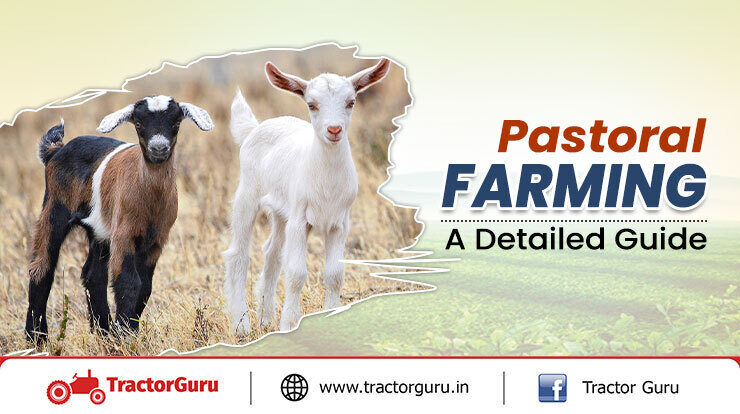
India’s employment vastly depends on agriculture which includes farming of numerous crops and cattle breeding. However, there are loads of advancements in this sector, which helps farming to modernise over time. One such advancement is Pastoral Cultivation. So, be with us till the end to know about Pastoral agriculture and the importance of Pastoral Farming in generating higher income for farmers.
What Is Pastoral Farming?
Pastoral farming is the practice of raising livestock instead of focusing on crop production. Moreover, there are some regions where this farming is known as livestock farming or ranching. Just as Arable farming focuses only on crop production, Pastoral agriculture exclusively deals with livestock breeding. This is the difference between arable and pastoral cultivation. It includes cattle raising, dairy farming or sheep breeding to obtain wool. This agricultural practice is carried out to have profitable income with less costing. Therefore, it can be adopted by those farmers who lack the suitable resources for other types of farming. However, the area which is required to breed a variety of animals is known as a Pastoral farm. And pastoral and farming communities go hand in hand.
Moreover, Pastoral cultivation has been generally classified in two categories :-
-
Traditional Pastoral Farming
In older times, the main objective of this farming was to raise sheep for dairy purposes and to achieve their wool.
-
Modern Pastoral Farming
Modern Pastoral agriculture includes a variety of animals such as cattle, sheep, goats and herds of different beings.
Benefits Of Pastoral Farming System
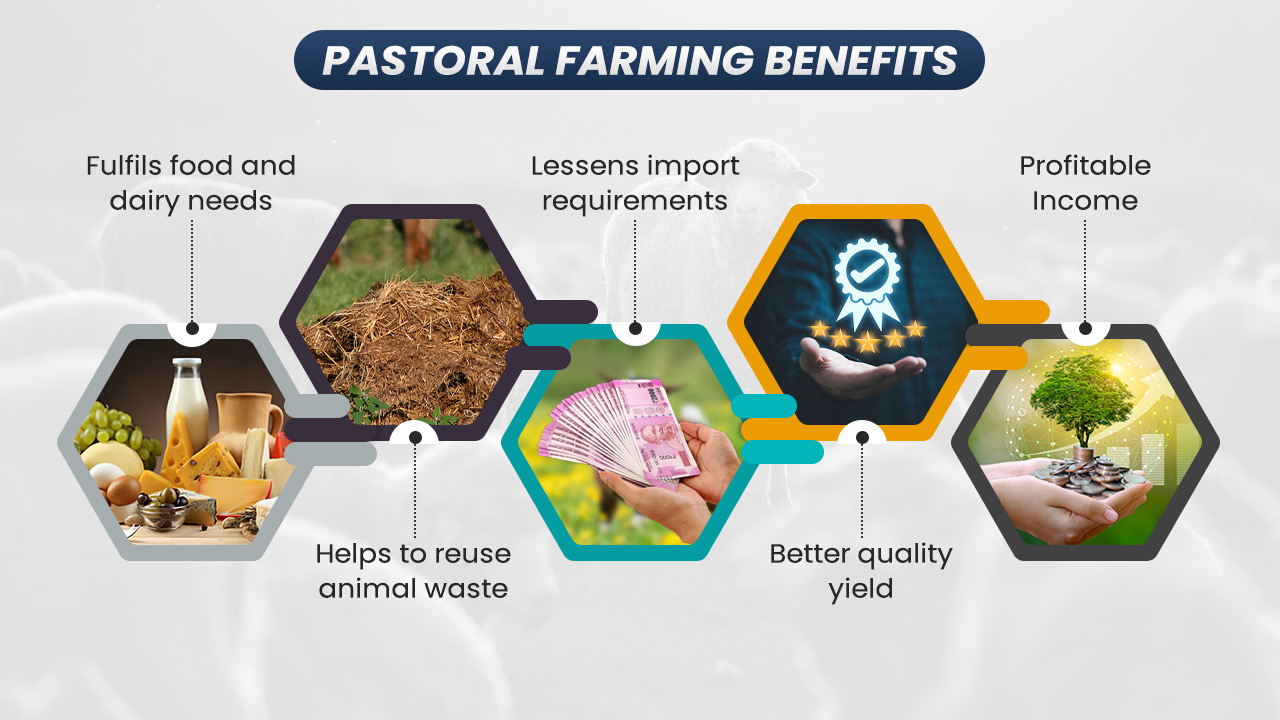
Pastoral Farming Benefits
1. Fulfils food and dairy needs
2. Helps to reuse animal waste
3. Lessens import requirements
4. Better quality yield
5. Profitable Income
Agro Pastoral cultivation has loads of benefits for today’s world, in terms of both economy and environment. Let us look at few of them :-
- It helps fulfil the demands of local markets for meat and dairy products.
- The waste produced by animals is used to provide nutrition to the crops for better yield.
- If we adopt Pastoral agriculture, we reduce the need to import goods.
- The output produced from this farming is full of nutrients and provides better health.
- It is a helpful alternative to obtain profitable income with minimal cost and resources.
Thus, we can vastly see the importance of the Pastoral cultivation system in many aspects.
Pastoralism :-
Pastoralism defines the nomadic herding of animals in large greenlands for obtaining their products.
Characteristics Of Pastoral Farming
Numerous factors determine the execution of Pastoral agriculture such as soil, topography, height of the land, sunlight exposure, and rainfall. In this, soil is responsible for deciding the grazing land and pasture for large animal herds. Apart from this, the climatic conditions ensure whether the animals can easily survive or not. Therefore, these characteristics are crucial for Pastoral agriculture. Furthermore, according to the land and expenditure, we can categorise this farming into two types.
-
Intensive Pastoral Farming
In this agro Pastoral farming system, the investment is high and land area is lesser, as we invest huge capital in the application of modern and effective machines. Hence, this results in easier breeding of animals.
-
Extensive Pastoral Farming
This farming has a large land area and capital invested in less. It is just opposite to intensive Pastoral cultivation as we use less money in a vast area of land. However, we can use both techniques in commercial pastoral farming.
** Fun Fact – Did you know that throughout the world, Pastoral farming and mixed crop production systems provide livelihood to around 120 million to 600 million people.
Types Of Pastoralism
There are different types of pastoral farming practices worldwide. And primarily, it consists of three types. So, let’s have a look at them.
-
Nomadic
As the name suggests, this type of Pastoralism is mainly mobile and there is minimum settlement at a particular location. Nomadic Pastoralism is significantly popular among the Saami tribes. And it is carried out to obtain animal products for self and commercial purposes.
-
Semisedentary
In this Pastoralism, most of the settled village population is responsible for breeding livestock. Moreover, the products obtained from this type of Pastoralism are used for income. However, it comprises a wide range of cultivation, such as hunting, horticulture and also various trades. The Navajo tribe is very famous for this Pastoralism.
-
Seminomadic
A Pastoralism where animal yields are a byproduct of hunting and crop production is popular as Seminomadic Pastoralism. The mobility of this type of animal breeding depends on the suitable season. The rest of the year, farmers do it in semi-permanent or permanent villages. Furthermore, it is popular in the Maasai community.
Pastoral Farming In India
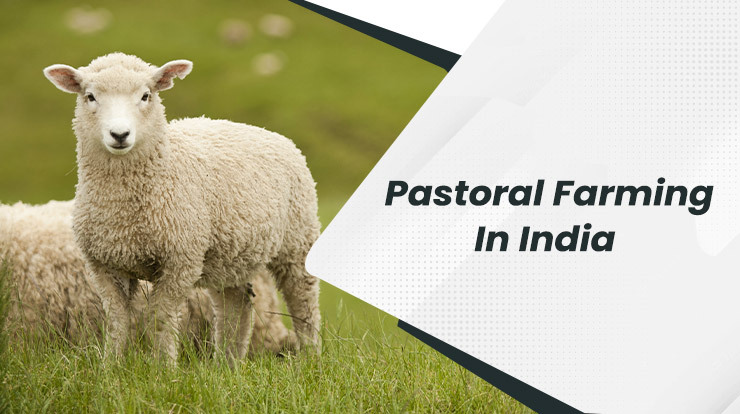
This farming is highly practised in India and there are different Pastoral communities which are known to mainly breed animals. Moreover, the people of these communities leave their homes with large herds between the summer and winter seasons. However, Indian Pastoral cultivation hugely comprises nomadic livestock farming, which diminishes the concept of Pastoral agriculture system.
Silvi Pastoral Farming
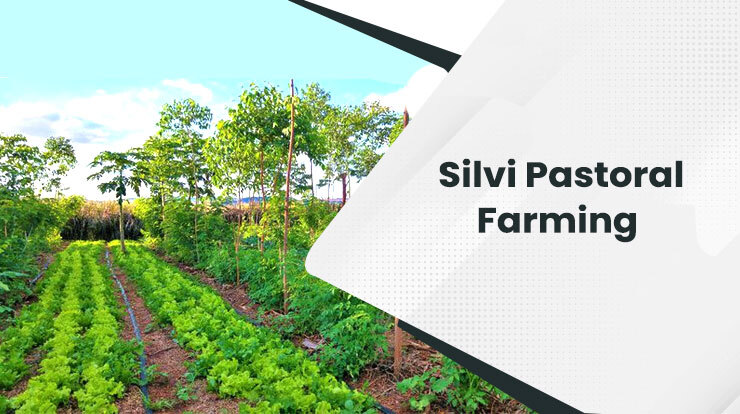
Agriculture is the epitome for providing the support to various biological factors on the earth. And this type of farming is one example of such. Silvi Pastoral farming constitutes production of pasture and woody plants, including large trees. These plants and trees provide shelter and food to the livestock and farmers can efficiently cut costs through this Pastoral cultivation. Moreover, farmers produce the animal waste to provide nutrition to the plants. In this way, Silvi Pastoral cultivation balances animals and the environment by reducing waste.
** Fun Fact – Currently, there are more than 200 million Pastoralists in the world and this number is estimated to be increasing over the next few years.
Difference Between Nomadic And Transhumance Pastoral Farming
Both the Nomadic and Transhumance Pastoral farming deals with animal breeding or livestock raising. But, In Nomadic Pastoral farming, there is an irregular roaming of herders and it does not depend on a particular season. On the other hand, Transhumance Pastoral farming is done in a selected season and for the rest of the season, it is carried out at a fixed location. Also, farmers produce some of the crops to support the animals.
Pastoral Farming Advantages And Disadvantages
Just like every concept has its merits and demerits, Pastoral cultivation also has both pros and cons. Let’s take a look at them.
Advantages Of Pastoral Farming
- It helps to boost the economy of the country.
- If we use the latest machines, we can generate output to provide enough export supplies through it.
- There is no need for major investment and it comprises a variety of output.
- Also, we can do Pastoral cultivation in those areas where crop production is not possible.
- It helps to produce employment as well, and we can utilise the unused land.
Disadvantages Of Pastoral Farming
- This farming requires a large land area.
- We have to sell animals to fulfil food requirements and this is difficult, as some people have an emotional connection to them.
- The land is also prone to soil erosion due to the possibility of overgrazing.
- There is a responsibility to save the animals from getting sick due to various factors.
- We have to find water accessibility to breed the livestock.
Increasing Pastoral Farming Awareness
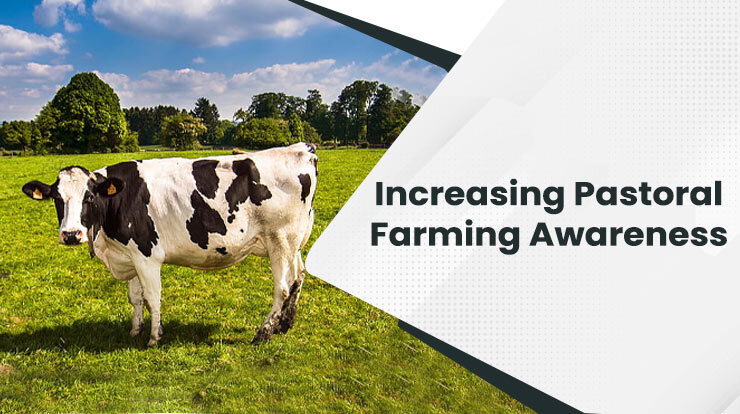
In order to increase Pastoral cultivation practice, we need to create awareness among farmers. There are many programs and campaigns that help to boost Pastoral cultivation. And these programs define the benefits and cost estimation for this farming, which is fairly low to other investments.
Conclusion
In this way, we have explained what is Pastoral Cultivation, its benefits, its advantages and disadvantages. Moreover, this farming is hugely beneficial for those farmers who do not have land of their own. Also, we can adopt this farming method to save our planet by reusing the unused resources of the earth.
We hope this blog will help you to learn everything about this farming and to read more such farming blogs, visit TractorGuru. This agriculture platform provides all the latest information regarding agriculture, and powerful farming machines.
Related Blogs:



